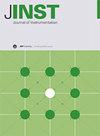Design and beam dynamics simulation of an 8 MeV compact accelerator-driven neutron source
IF 1.3
4区 工程技术
Q3 INSTRUMENTS & INSTRUMENTATION
引用次数: 0
Abstract
A compact accelerator-driven neutron source is proposed at Sino-French Institute of Nuclear Engineering and Technology, Sun Yat-Sen University, called Sun Yat-Sen University Proton Accelerator Facility (SYSU-PAFA). The proton accelerator is composed of a proton electron cyclotron resonance source, a four-vane radio frequency quadrupole (RFQ), and an alternative phase focusing drift tube linac (APF-DTL). It can accelerate 10 mA proton beam to 8 MeV. Due to the high current, beam matching is particularly important. In order to achieve beam matching between various components, beam transport sections are needed. The beam transport line is divided into three segments. The Low Energy Beam Transport (LEBT) ensures that the beam parameters are matched before entering the RFQ. The Medium Energy Beam Transport (MEBT) segment efficiently transfers the beam between the RFQ and DTL. The High Energy Beam Transport (HEBT) focuses on transporting the beam to the targets. The design goal of beam transport line is as short as possible while ensuring high efficiency of beam transportation. SYSU-PAFA has an overall transmission efficiency of 99%, with optimal transverse matching conditions between beam transport and RFQ or DTL accelerators. The efficient use of solenoids and magnets allows for a compact transmission section, resulting in a total length of 13.6 meters, shorter than most accelerators at the same beam energy. This paper will provide the detailed beam dynamics of the compact accelerator.8 MeV 紧凑型加速器驱动中子源的设计与束流动力学模拟
中山大学中法核工程与技术研究院(Sino-French Institute of Nuclear Engineering and Technology, Sun Yat-sen University)提出了一种紧凑型加速器驱动中子源,称为中山大学质子加速器(Sun Yat-sen University Proton Accelerator Facility,SYSU-PAFA)。该质子加速器由质子电子回旋共振源、四叶片射频四极杆(RFQ)和替代相聚焦漂移管直列加速器(APF-DTL)组成。它能将 10 mA 质子束加速到 8 MeV。由于电流很大,束流匹配尤为重要。为了实现不同组件之间的光束匹配,需要光束传输部分。束流传输线分为三个部分。低能量光束传输(LEBT)确保光束参数在进入 RFQ 之前就已匹配。中能光束传输段(MEBT)在 RFQ 和 DTL 之间有效传输光束。高能光束传输(HEBT)主要是将光束传输到目标。光束传输线的设计目标是在确保高效光束传输的同时,尽可能缩短传输线。SYSU-PAFA 的总体传输效率高达 99%,光束传输与 RFQ 或 DTL 加速器之间的横向匹配条件最佳。电磁铁和磁铁的高效使用使得传输部分结构紧凑,总长度为 13.6 米,比相同光束能量下的大多数加速器都要短。本文将详细介绍紧凑型加速器的光束动力学特性。
本文章由计算机程序翻译,如有差异,请以英文原文为准。
求助全文
约1分钟内获得全文
求助全文
来源期刊

Journal of Instrumentation
工程技术-仪器仪表
CiteScore
2.40
自引率
15.40%
发文量
827
审稿时长
7.5 months
期刊介绍:
Journal of Instrumentation (JINST) covers major areas related to concepts and instrumentation in detector physics, accelerator science and associated experimental methods and techniques, theory, modelling and simulations. The main subject areas include.
-Accelerators: concepts, modelling, simulations and sources-
Instrumentation and hardware for accelerators: particles, synchrotron radiation, neutrons-
Detector physics: concepts, processes, methods, modelling and simulations-
Detectors, apparatus and methods for particle, astroparticle, nuclear, atomic, and molecular physics-
Instrumentation and methods for plasma research-
Methods and apparatus for astronomy and astrophysics-
Detectors, methods and apparatus for biomedical applications, life sciences and material research-
Instrumentation and techniques for medical imaging, diagnostics and therapy-
Instrumentation and techniques for dosimetry, monitoring and radiation damage-
Detectors, instrumentation and methods for non-destructive tests (NDT)-
Detector readout concepts, electronics and data acquisition methods-
Algorithms, software and data reduction methods-
Materials and associated technologies, etc.-
Engineering and technical issues.
JINST also includes a section dedicated to technical reports and instrumentation theses.
 求助内容:
求助内容: 应助结果提醒方式:
应助结果提醒方式:


